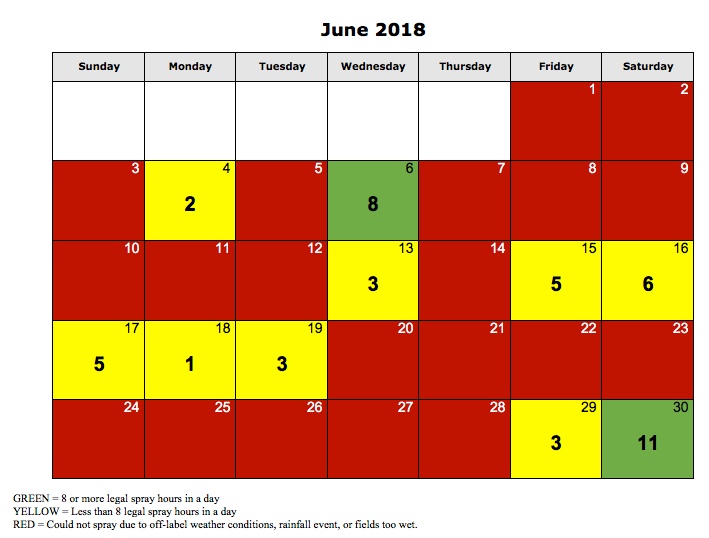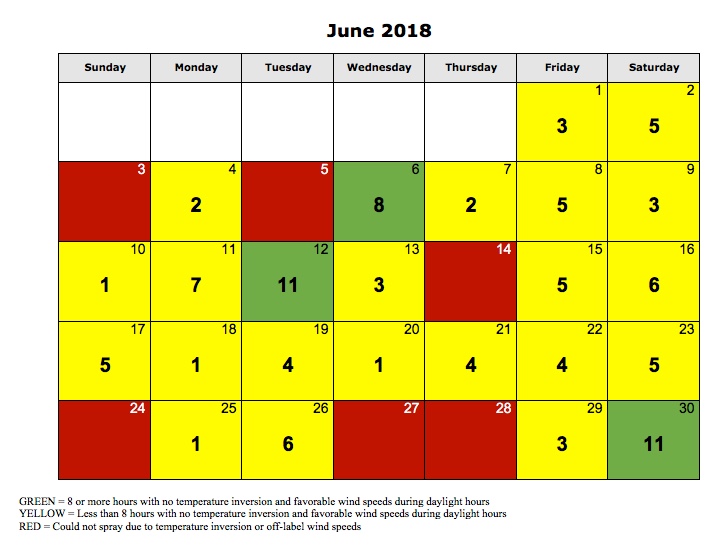Authors: Joe Ikley and Bill Johnson
Now that we are in the middle of July and most herbicide applications in corn and soybean should have ended, we wanted to take a look back at June this year. Specifically, we wanted to look at the weather this past June with regards to the labels for Engenia, FeXapan, and Xtendimax. Last year we used weather data from the Agronomy Center for Research and Education (ACRE) near West Lafayette to determine how many hours were available to legally apply these products. This year, we installed new weather stations at Throckmorton Purdue Agricultural Center (TPAC) in Lafayette. A few improvements with our new weather stations are that we have the ability to measure for temperature inversions, and that we have our wind gauge placed 3 feet above the ground, which would be about the maximum boom height for a postemergence application of those three products.
As a reminder of some of the limitations on these product labels, we can only make applications when the wind speed is between 3 and 10 MPH, and the Office of the Indiana State Chemist (OISC) and herbicide registrants also include a wind gust over 10 MPH as a label violation. Applications are prohibited during a temperature inversion, and applications can only be made between sunrise and sunset. We are also not supposed to make applications within 24 hours of a forecast rain event. Knowing that applicators were given the ability to use their preferred weather source for rainfall predictions, and the hit-and-miss nature of many of our rain events this year, we did not include the 24 hour restriction when we calculated spray hours this June. To determine the legal hours in June for this year, we combined the weather station data with the rainfall events at TPAC and how often the farm (i.e. Pete) was able to get their commercial sprayer onto a field for any type of pesticide application. When we packaged everything together, there were 47 hours across the month of June to legally apply Engenia, FeXapan, and Xtendimax at TPAC this year.

Figure 1. Spray days in June 2018 at the Throckmorton Purdue Agricultural Center (TPAC) near Lafayette, IN. If a box is red, there were no spray hours that day due to field conditions. If a box is green, there were 8 or more hours in a day where winds were between 3 and 10 MPH (including gusts) and no temperature inversion present. If a box is yellow, there were less than 8 hours in a day where winds were between 3 and 10 MPH (including gusts) and no temperature inversion present.
We are also aware that many areas of the state were very dry in June. To get a better picture of overall wind and temperature inversion data for the Lafayette region, we made a second calendar that ignored rainfall and soil conditions. We found that we had 106 hours throughout June where we had on-label wind conditions, and no temperature inversion. We did not factor wind direction into these calendars, so it’s important to remember that an application is not allowed when a sensitive crop is downwind. So as far as applications go, these calendars are a “best case” situation where you do not have any sensitive crop downwind of an application.

Figure 2. Hours with on-label wind and no temperature inversions in June 2018 at the Throckmorton Purdue Agricultural Center (TPAC) near Lafayette, IN. If a box is red, there were no spray hours that day due to off-label wind or temperature inversions. If a box is green, there were 8 or more hours in a day where winds were between 3 and 10 MPH (including gusts) and no temperature inversion present. If a box is yellow, there were less than 8 hours in a day where winds were between 3 and 10 MPH (including gusts) and no temperature inversion present.
The data we collected this year reinforces the fact that we do not have very many hours in the real world where we can be completely compliant with the restrictions on the new dicamba product labels. The OISC is still receiving several dicamba-related complaints, and so far the pace of complaints is exceeding last year, so the story of how successful we have been at keeping dicamba in our target fields has yet to be fully determined. The fact remains that we need to have a backup plan in place for fields with an intended postemergence application of dicamba since our hours for legal applications are limited throughout the month of June.


